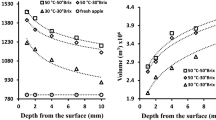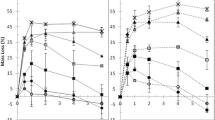Abstract
Mass transfer was evaluated during osmotic dehydration of pineapple in solutions with until four components aiming to investigate the solutes concentration influence on impregnation. In the first step, the experimental trials for optimization of solution concentration were based on 23 factorial design. In the second step, effective diffusion coefficients were determined. Equations representing the influence of the concentration of sucrose, calcium lactate, and ascorbic acid in osmotic solutions on water loss and gains of sucrose, calcium, and vitamin C were found. Results showed that both calcium lactate and sucrose concentration affected calcium and sucrose gain. On the other hand, only vitamin C gain was significantly affected by the ascorbic acid concentration in the studied concentration range. However, when comparing diffusivities in pineapple immersed in sucrose solutions, with and without calcium lactate, with and without ascorbic acid, it was possible to verify that diffusivities of water, sugar, and calcium increased in presence of ascorbic acid in solution. Calcium in solution diminished the water and sucrose diffusivities. High calcium and vitamin C contents were obtained in 1 h immersion in the solutions studied.





Similar content being viewed by others
Abbreviations
- M :
-
mass (kg)
- M 0 :
-
initial mass (kg)
- ΔM:
-
total mass variation in relation to initial mass (dimensionless)
- R2 :
-
determination coefficient (dimensionless)
- ΔG SUC :
-
sugar gain in relation to initial mass (dimensionless)
- ΔG Ca :
-
calcium gain in relation to initial mass (dimensionless)
- ΔG VitC :
-
Ascorbic acid gain in relation to initial mass (dimensionless)
- ΔW :
-
water loss in relation to initial mass (dimensionless)
- β 0 β 1 β 2, β 3, β 12, β 13, β 23, β 123 :
-
estimated regression coefficient of the Eq. (1)
- w w :
-
water content
- w SUC :
-
sucrose content
- w Ca :
-
calcium content
- w VitC :
-
ascorbic acid content
- \( \overline{{{w_i}}}(t) \) :
-
mean concentration of the component for a time (t)
- ADM (SUC) :
-
dimensionless sucrose content
- ADM (Ca ):
-
dimensionless calcium content
- ADM (VitC) :
-
dimensionless vitamin C content
- ADM (w) :
-
dimensionless water content
- SUC :
-
sucrose concentration (%)
- LAC :
-
calcium lactate concentration (%)
- VitC :
-
Ascorbic acid concentration (%)
- Coded variables:
-
x 1i ; x 2i ; x 3i ; (1 = SUC, 2 = LAC, 3 = VitC)
- Response variables:
-
Y i (Y 1 = water loss (ΔW); Y 2 sucrose gain (ΔG SUC ); Y 3 calcium gain (ΔG Ca ); Y 4 Ascorbic acid gain (ΔG VitC ));
- Calc :
-
calculated
- exp:
-
experimental
- OD:
-
osmotically dehydrated
- S :
-
sucrose
- Ca :
-
calcium
- VitC :
-
ascorbic acid (vitamin C)
- w :
-
water
- 0:
-
initial state
References
Aminzadeh, R., Sargolzaei, J., & Abarzani, M. (2010). Preserving melons by osmotic dehydration in a ternary system followed by air-drying. Food and Bioprocess Technology, 5(4), 1305–1316.
Anino, S. V., Salvatori, D. M., & Alzamora, S. M. (2006). Changes in calcium level and mechanical properties of apple tissue due to impregnation with calcium salts. Food Research Internacional, 39, 154–164.
AOAC - Association of Official Analytical Chemists. (1970). Official Methods of Analysis of the Association of Official Analytical Chemists (11th ed.). Arlington: Association of Official Analytical Chemists AOAC.
AOAC - Association of Official Analytical Chemists. (1984). Official Methods of Analysis of the Association of Official Analytical Chemists (14th ed.). Arlington: Association of Official Analytical Chemists AOAC.
AOAC - Association of Official Analytical Chemists (1995) Official Methods of Analysis of the Association of Official Analytical Chemists, 16th ed., v. 1, Arlington: Association of Official Analytical Chemists A.O.A.C., chapter 3. p. 4. (method 985.01).
Atkins, C. D., & Rouse, A. H. (1953). Time-temperature relationships for heat inactivation of pectinesterase in citrus juices. Food Technology, Chicago, 7(12), 489–491.
Barrera, C., Betoret, N., Corell, P., & Fito, P. (2009). Effect of osmotic dehydration on the stabilization of calcium-fortified apple slices (var. Granny Smith): Influence of operating variables on process kinetics and compositional changes. Journal of Food Engineering, 92, 416–424.
Benassi, M. T., & Antunes, A. J. (1988). A comparison of meta-phosphoric and oxalic acids as extractant solutions for the determination of vitamin C in selected vegetables. Arquivos de Biologia e Tecnologia, 31(4), 507–513.
Collet, L. S. F. C. A., Shigeoka, D. S., Badolato, G. G., & Tadini, C. C. (2005). A kinetic study on pectinesterase inactivation during continuous pasteurization of orange juice. Journal of Food Engineering, 69, 125–129.
Crank, J. (1975). The Mathematics of Diffusion (2nd ed.). London: Clarendon Press-Oxford.
Crapiste, G. H., Whitaker, S., & Rotstein, E. (1988). Drying a cellular material - I. A mass transfer theory. Chemical Engineering Science, 43(11), 2919–2928.
Ferrari, C. C., Carmello-Guerreiro, S. M., Bolini, H. M. A., & Hubinger, M. D. (2010). Structural changes, mechanical properties and sensory preference of osmodehydrated melon pieces with sucrose and calcium lactate solutions. International Journal of Food Properties, 13, 112–130.
Fito, P., Chiralt, A., Betoret, N., Gras, M., Cháfer, M., Martínez-Monzó, J., Andrés, A., & Vidal, D. (2001). Vacuum impregnation and osmotic dehydration in matrix engineering. Application in functional fresh food development. Journal of Food Engineering, 49, 175–183.
Garcia, C. C., Mauro, M. A., & Kimura, M. (2007). Kinetics of osmotic dehydration and air drying of pumpkins (Cucurbita moschata). Journal of Food Engineering, 82, 284–291.
Henrion, P. N. (1964). Diffusion in the sucrose + water system. Transactions of the Faraday Society, 60, 72–82.
Katz, F. (2000). Research priorities more toward healthy and safe. Food Technology, 54(12), 42–44.
Lenart, A. (1996). Osmo-convective drying of fruits and vegetables: technology and application. Drying Technology, 14(2), 391–413.
Mastrantonio, S. D. S., Pereira, L. M., & Hubinger, M. D. (2005). Osmotic dehydration kinetics of guavas in maltose solutions with calcium salt. Alimentos e Nutrição, 16(4), 309–314.
Mavroudis, N. E., Gidley, M. J., & Sjöholm, I. (2012). Osmotic processing: effects of osmotic medium composition on the kinetics and texture of apple tissue. Food Research International, 48, 839–847.
Meyer, R. H. (1971). Response Surface Methodology (pp. 126–175). Boston: Allen and Bacon.
Monerat, S. M., Pizzi, T. R. M., Mauro, M. A., & Menegalli, F. C. (2010). Osmotic dehydration of apples in sugar/salt solutions: concentration profile and effective diffusion coefficients. Journal of Food Engineering, 100, 604–612.
Montgomery, D. C. (1991). Análisis y Diseño Experimental. Mexico: Grupo Editorial Iberoamerica.
Pereira, L. M., Ferrari, C. C., Mastrantonio, S. D. S., & Rodrigues, A. C. C. (2006). Kinetic aspects, texture, and color evaluation of some tropical fruits during osmotic dehydration. Drying Technology, 24, 475–484.
Qi, H., Le Maguer, M., & Sharma, S. K. (1998). Design and selection of processing conditions of a pilot scale contactor for continuous osmotic dehydration of carrots. Journal of Food Processing and Engineering, 21, 75–88.
Ramallo, L. A., & Mascheroni, R. H. (2010). Dehydrofreezing of pineapple. Journal of Food Engineering, 99, 269–275.
Raoult-Wack, A. L. (1994). Recent advances in the osmotic dehydration of foods. Trends in Food Science and Technology, 5, 255–260.
Robbers, M., Singh, R. P., & Cunha, L. M. (1997). Osmotic-convective dehydrofreezing process for drying kiwifruit. Journal of Food Science. Chicago, 62(5), 1039–1047.
Saputra, D. (2001). Osmotic dehydration of pineapple. Drying Technology, 19, 415–425.
Sereno, A. M., Moreira, R., & Martinez, E. (2001). Mass transfer coefficients during osmotic dehydration of apple in single and combined aqueous solutions of sugar and salt. Journal of Food Engineering, 47, 43–49.
Silva, W.P. and Silva, C.M.D.P.S. (2008) Prescribed adsorption–desorption V 2.2, online, available from world wide web: http://zeus.df.ufcg.edu.br/labfit/Prescribed.htm, date of access: Septembre, 20
Silva, A. C., Silva, C. R., Costa, L. M. S., Barros, N. A. M., Viana, A. S., Koblitz, M. G. B., & Souza, F. V. D. (2011a). Use of response surface methodology for optimization of the extraction of enzymes from pineapple pulp. Acta Horticulturae, 902, 575–584.
Silva, K. S., Caetano, L. C., Garcia, C. C., Romero, J. T., Santos, A. B., & Mauro, M. A. (2011b). Osmotic dehydration process for low temperature blanched pumpkin. Journal of Food Engineering, 105, 56–64.
Singh, B., Kumar, A., & Gupta, A. K. (2007). Study of mass transfer kinetics and effective diffusivity during osmotic dehydration of carrot cubes. Journal of Food Engineering, 79, 471–480.
Wilinska, A.; Rodrigues, A. S. F.; Bryjak, J.; Polakovic, M. (2008) Thermal inactivation of exogenous pectin methylesterase in apple and cloudberry juices. Journal of Food Engineering 85, 459exog
Zemke-White, W. L., Clements, K. D., & Harris, P. J. (2000). Acid lysis of macroalgae by marine herbivorous fishes: Effects of acid pH on cell wall porosity. Journal of Experimental Marine Biology and Ecology, 245, 57–68.
Acknowledgments
The authors would like to thank CAPES for the scholarship, PURAC Synthesis (Brazil) and Prozyn (Brazil).
Author information
Authors and Affiliations
Corresponding author
Rights and permissions
About this article
Cite this article
Silva, K.S., Fernandes, M.A. & Mauro, M.A. Osmotic Dehydration of Pineapple with Impregnation of Sucrose, Calcium, and Ascorbic Acid. Food Bioprocess Technol 7, 385–397 (2014). https://doi.org/10.1007/s11947-013-1049-0
Received:
Accepted:
Published:
Issue Date:
DOI: https://doi.org/10.1007/s11947-013-1049-0




